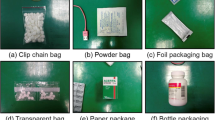Abstract
The abundance of counterfeit medicine especially in countries like Bangladesh is causing a serious threat to public health. Several invasive approaches and lab-based methods are available but not affordable by the common people neither in terms of money nor in terms of specialist knowledge. In this paper, we proposed a non-invasive alert system to separate approved brands of pharmaceutical companies from fake or banned brands using logo images of the company taken using a mobile phone. Later, if the logo is identified as from an approved brand, then we check if the logo is real or fake. If the logo is not listed in the approved brands or in the list of banned brands or the logo is fake, the system will alert the user about probable fake medicine. We used the pre-trained VGG-16 model through transfer learning and obtained 96% test accuracy in brand recognition and 84% test accuracy in fake detection.
Access this chapter
Tax calculation will be finalised at checkout
Purchases are for personal use only
Similar content being viewed by others
Notes
- 1.
- 2.
inkscape.org.
References
Low-quality drug production: Ban stays on 20 drug companies. The Daily Star (2017). https://www.thedailystar.net/frontpage/low-quality-drug-production-ban-stays-20-drug-companies-1360867
Alsallal, M., Sharif, M.S., Al-Ghzawi, B., Mlkat al Mutoki, S.M.: A machine learning technique to detect counterfeit medicine based on x-ray fluorescence analyser. In: 2018 International Conference on Computing, Electronics Communications Engineering (iCCECE), pp. 118–122 (2018)
Barstis, T.L.O., Flynn, P.P., Lieberman, M.: Analytical devices for detection of low-quality pharmaceuticals, May 2016
Chollet, F.: keras. https://github.com/fchollet/keras (2015)
Davison, M.: Pharmaceutical Anti-Counterfeiting: Combating the Real Danger from Fake Drugs. John Wiley Inc. (2011)
Deng, J., Dong, W., Socher, R., Li, L.J., Li, K., Fei-Fei, L.: ImageNet: a large-scale hierarchical image database. In: CVPR09 (2009)
Goodfellow, I., Bengio, Y., Courville, A.: Deep Learning. The MIT Press (2016)
Komsta, L., Waksmundzka-Hajnos, M., Sherma, J.: Thin Layer Chromatography in Drug Analysis, 1 edn. CRC Press (2013)
Leem, J.W., et al.: Edible unclonable functions. Nature Commun. 11, 328 (2020)
NeuroTags: How counterfeiting can be solved with the AI monitored serialization technology. White paper (2019). https://www.neurotags.com/white-papers/foolproof-anti-counterfeiting-technology
Sample, I.: Fake drugs kill more than 250,000 children a year, doctors warn. The Guardian (2019). https://www.theguardian.com/science/2019/mar/11/fake-drugs-kill-more-than-250000-children-a-year-doctors-warn
Serban, A., Ilaş, G., Poruşniuc, G.C.: SpotTheFake: an initial report on a new CNN-enhanced platform for counterfeit goods detection (2020)
Sharma, A., Srinivasan, V., Kanchan, V., Subramanian, L.: The fake vs real goods problem: Microscopy and machine learning to the rescue. In: Proceedings of the 23rd ACM SIGKDD International Conference on Knowledge Discovery and Data Mining, KDD 2017, pp. 2011–2019. Association for Computing Machinery, New Yor (2017). https://doi.org/10.1145/3097983.3098186
Simonyan, K., Zisserman, A.: Very deep convolutional networks for large-scale image recognition (2015)
Wadud, M.: Bangladesh’s battle with fake and low-standard medicine. The New Humanitarian (2012). https://www.thenewhumanitarian.org/feature/2013/11/04/bangladesh-s-battle-fake-and-low-standard-medicine
Acknowledgement
Thanks to the Institute of Energy, Environment, Research and Development (IEERD), University of Asia Pacific for funding the registration fee.
Author information
Authors and Affiliations
Corresponding author
Editor information
Editors and Affiliations
Rights and permissions
Copyright information
© 2021 The Author(s), under exclusive license to Springer Nature Singapore Pte Ltd.
About this paper
Cite this paper
Ferdosi, B.J., Sakib, M.A., Islam, M.S., Dhar, J. (2021). Identifying Counterfeit Medicine in Bangladesh Using Deep Learning. In: Zimmermann, A., Howlett, R.J., Jain, L.C., Schmidt, R. (eds) Human Centred Intelligent Systems . KES-HCIS 2021. Smart Innovation, Systems and Technologies, vol 244. Springer, Singapore. https://doi.org/10.1007/978-981-16-3264-8_5
Download citation
DOI: https://doi.org/10.1007/978-981-16-3264-8_5
Published:
Publisher Name: Springer, Singapore
Print ISBN: 978-981-16-3263-1
Online ISBN: 978-981-16-3264-8
eBook Packages: Intelligent Technologies and RoboticsIntelligent Technologies and Robotics (R0)




